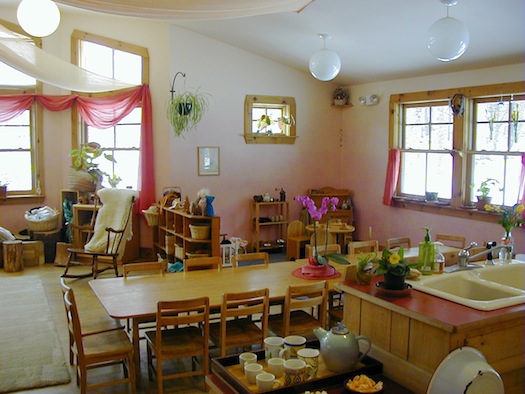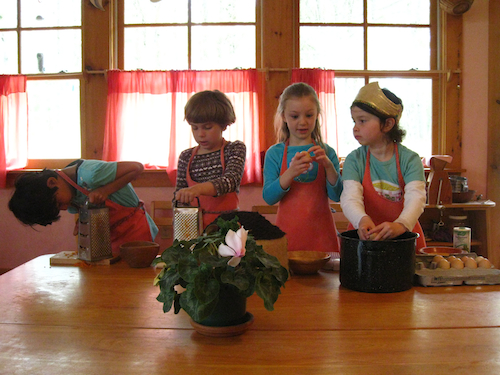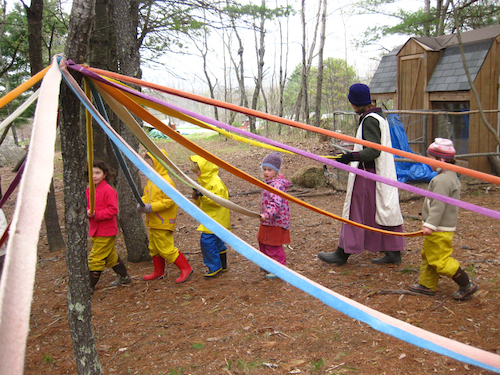As part of SimpleHomeschool’s ”A Day in the Life” series, I have contributed another guest post which appears today: “A Day in the Life of a Waldorf Kindergarten.” I describe the “Rhythm of the Day” in a Waldorf kindergarten classroom. Or more specifically, a day in my Waldorf classroom. The picture I give is of a typical “Soup Day,” as the children would fondly refer to Tuesday.
Names of the days of the week are a meaningless abstraction for young children, but the children in my class knew that Rice Day was always followed by Soup Day, and then in turn comes Bread Day, Millet Day and Oatmeal Day.
The children also knew that on Rice Day we painted, on Soup Day we chopped vegetables, on Bread Day we kneaded dough, on Millet Day we colored with beeswax crayons, and on Fridays we polished and cleaned our classroom. It was all part of the “Rhythm of the Week.”
Seasonally, the children would experience the “Rhythm of the Year” by preparing for and celebrating the festivals of the year—Michaelmas in September, All Hallow’s Eve, Martinmas, Advent, St. Nicholas Day, Christmas, Valentine’s Day, Easter, and May Day. Festivals are a much more meaningful way for a child to mark the passage of a year than dates on a calendar.
As human beings, we are creatures of rhythm—from the moment we are born, our hearts beat, our blood pulses, and our lungs beat to a steady rhythm. We give children a gift and nourish their healthy development by being mindful of a young child’s need for rhythm, and offering them consistency, and the comfort of knowing what comes next, as we move through our days, weeks, and years together with them.
![]()
How do you find ways to honor the rhythm of the days, weeks and years with your children? Do you find it challenging to be consistent? Please share your suggestions and struggles!







17 Comments
Wow what a wonderful day. Lucky, lucky blessed children. Thanks for sharing. I am printing this out to keep in my kindergarten file as something to strive toward.
And lucky blessed teacher! The children and the rhythm of our mornings enriched me so much. While I love what I’m doing now, writing the piece for SimpleHomeschool made me very wistful for being in the classroom.
While preparing to open a Waldorf inspired child care program, one piece of advice stuck out for for me regarding rhythm, and I have since heard others mention the same idea. That is following the rhythm of the breath throughout the day, allowing for activities reflective of the inhale (bigger more physical activities) balanced with those more in line with an exhale (smaller, softer, more quiet activities). This helped me tremendously. The lull and the lilt, the up and the down, the in and the out…
Warmly,
Laura
Yes, Laura! As Waldorf teachers we always strive to have a breathing quality to the day. Again, rhythm. That is that certain activities, like free play, have the quality of an exhalation or “out breath,” while other activities, like story time, have an “in breath” quality.
In planning the rhythm of our mornings, we try to alternate “in-breathing” activities with “out-breathing activities.” In the example of my kindergarten morning, free play (out breath) was followed by circle time and rest time (in breath), followed by outdoor play (out breath) followed by story time (in breath).
You get the idea!
I’ve been teaching an early childhood Hebrew School program (once a week, younger kids even less) I’ve been trying to “do” Waldorf ideas, but am finding it difficult in a school setting that is not everyday. I would love some inspiration, and perhaps some places to look for Jewish Waldorf experiences to give myself some inspiration.
Leigh, here’s a link to the Harduf Waldorf School and Kibbutz in Israel. Perhaps it would be a good place to start: http://www.kamah.org.il/eng/kibutz.asp
Oh, I absolutely love this. It feels so good. I am a big fan of Waldorf ideas, and you bring it into the tangible. The photos of the room just feel so warm, soft, and gentle. I think definitely much of my little-girl-self feels nurtured and held in implementing this in my own home. Ahhh. Thank you.
Thanks, Tiffanie. When I stepped into a Waldorf kindergarten classroom for the very first time, it inspired the very feelings that you describe.
I knew then and there that I wanted to become a Waldorf teacher, and later came to realize how much my little girl self (who grew up in a very different environment) needed the healing that this kind of environment provides.
I really appreciated your guest post and gained a lot from it. My girls won’t get to attend a Waldorf school but I take what I can to provide it at home now and in the future, so thank you for sharing your experiences and insight. Also, the classroom is so beautiful, a great inspiration!
Hi Sarah,
I am brand spanking new to the homeschooling journey with my 2nd child, and am leaning heavily toward Steiner influence with him. This post has given me such inspiration, thank you!
I definitely have consistency issues, so tuning into our rhythms will be great for me as well. : )
No matter what method of homeschooling you choose, Nic, bringing consistent rhythm to your day will greatly benefit you and your children. Blessings on your homeschooling journey!
As a parent of teens, I feel that what I learned about Waldorf Early Childhood applies in many ways to early adolescence. Keeping a good rhythm is a life-long skill!
I just stumbled onto your blog and have been reading all of your posts! I am wondering if you can recommend books for helping establish the Rhythm of the Day?
Also, your photos of your classroom are beautiful. I love the pine wood. How warm!
How do festival preparations fit into the classroom rhythm? Is it an invitation between the morning work and free play? Something else?
Thanks for your question, Cameo. It is really up to each teacher in planning their day when to fit in festival preparation, and depends on whether it’s a kindergarten classroom or grade school There is no rule. In my kindergarten class, we would most likely do this work first thing in the morning, followed by free play, then followed by clean up and rest time. Hope this helps.
I am a sponge soaking it all in and loving it. I have been working with children for twenty years and now am beginning a journey toward Waldorf education. I am so excited. Where can I learn more?
Hello Sarah, in my kindergarten pod we meet from 10 to 2 and I am having a hard time defining my rhythm because we start late…now after winter break I am feeling that I might need to tweak it around a bit… I am noticing that you don’t have a snack time in the rhythm. Do your students don’t eat snacks at all? Only lunch? That makes me wonder if I should eliminate my snack, specially since we start at 10…I also don’t do quiet time… My rhythm so far is: playtime in the classroom for 15 min – circle time- snack time- free play – bread making/watercolor/craft- storytime -lunch -play outside – pick up outside. Any recommendations? Thank you!